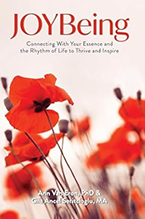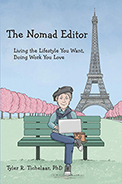June 23, 2025
JOYBeing:
Connecting With Your Essence and the Rhythm of Life to Thrive and Inspire
Ann Van Eron and Gila Ancel Seritcioglu
Open View Press (2025)
ISBN: 978-0-9975136-1-5
E-book ISBN: 978-0-9975136-4-6
New Book Explores How to Experience More Joy and Thrive
 JOYBeing: Connecting With Your Essence and the Rhythm of Life to Thrive and Inspire is a dynamic new book by Ann Van Eron and Gila Ancel Seritcioglu that encourages us all to seek moments of joy in our lives and shows us how to find them.
JOYBeing: Connecting With Your Essence and the Rhythm of Life to Thrive and Inspire is a dynamic new book by Ann Van Eron and Gila Ancel Seritcioglu that encourages us all to seek moments of joy in our lives and shows us how to find them.
The authors believe the need for joy is more necessary now than ever before. With all the turmoil and polarity in our world, all the conflicts, climate change concerns, technological disruptions, etc., it is easy for us to feel disconnected from ourselves and others. However, emotions are contagious, so if we strive to be joyful, we can spread joy and hope to others, creating a better future for everyone.
Ann and Gila coined the phrase “JOYBeing,” which they define as “connecting with awareness to the internal energy of aliveness in us as we experience and manage the challenges and joys of life…. JOYBeing is the joy of being alive. It is our ability to be awake to experience all facets of the rhythm of life.”
Using a garden metaphor, the authors show us how to plant seeds of JOYBeing. We can do this by being open to experiences so the seeds have a place to grow. We also need to prune and weed our thoughts to remove our inner clutter and give the joy seeds room to flourish.
Interspersed throughout the chapters are examples from both Ann and Gila of how they have experienced JOYBeing. They share their story of how they met twenty years ago at a conference and discussed how they both wanted more joy in their lives. Since then, they have continued that friendship from opposite ends of the world—Ann in Chicago, Gila in Istanbul—but their experiences have been very similar; for example, both women had to learn how to cope with sending their daughters off to college and still finding joy.
Making a space for joy and allowing themselves to feel it was a major struggle for both of them. Gila states:
“Despite my Hebrew name, which means joy, I was disconnected from joy and felt like I wasn’t good enough, even when I was trying to do my best. I felt unseen as a child, and I longed to be recognized for who I truly was, even though my parents were doing their best for me in their own ways.”
As for Ann, she describes her struggle this way:
“I was the oldest of six children in a family of modest means. I took on many responsibilities and learned to work hard. My parents, both good people, had very different perspectives and argued often. My family faced many challenges, and life seemed to be a struggle with little room for joy. A strong religious background reinforced my propensity for being selfless and giving to others. I didn’t think I could or should experience joy when so many around me were suffering. Joy seemed elusive to me.”
Just what is this joy the authors seek? They define joy as “a momentary internal positive experience that creates a sense of aliveness and excitement that enhances our energy for living and connection.”
While we might feel joy is out of reach, Gila and Ann reveal it is always available to us. We can easily convince ourselves we don’t have time for it in our busy schedules, but it can be found in small moments. It doesn’t have to be a major experience time-wise. For example, Ann says, “I had the misconception that joy had to be grand, like an exuberant burst overflowing with dancing and singing, which seemed beyond my reach.” However, she discovered joy can be subtle and is in reach all around us. We can embrace moments of joy such as simply appreciating a sunny day, helping someone, feeling good about finishing a task, or hearing a cat purr.
To allow joy in, we need to become aware of our desire for it and avoid the negative thoughts that limit it. The authors cite Rick Hanson who, in his book Hardwiring Happiness, remarks how we are like Teflon for the positive and Velcro for the negative. We need to reverse that scenario so our happy thoughts stick. We also need to be mindful of how we use our energy and where we place our intentions to ensure they leave room for joy.
The path to JOYBeing, according to the authors, is cultivated by following four steps: setting an intention, being aware, making a choice, and engaging in practice. We need to continually check in with ourselves, noticing our mood and emotions and seeking to shift them if they are not in a positive place. The book includes multiple practical tools to connect with joy. Each chapter concludes with many useful practices for the reader to take the information they have learned, reflect on their state of JOYBeing, and then determine how to increase their joy.
One valuable practice we all are likely to struggle with is remembering to be present. It is easy to get caught up in worries about tomorrow. For example, we may eat dinner without knowing what we are eating because our minds are somewhere else.
As Gila states, we want to be in an “inquiry state” where we are “not fixing, but awakening to our feelings, attending to them in the present moment as they are happening, allowing them space so a new course of action can emerge.”
Being conscious of our feelings is only part of awareness. The authors clarify that an emotion lasts ninety seconds in our body. Yet the story we create around the emotion can cause us to keep repeating it. We need awareness so we can separate the story from the emotions and be less a victim and more at choice. We also need to be aware of our inner critic, being gentle with it because it means to protect us, but not letting it stop us from experiencing joy. Rather than connecting with our inner critic, we benefit from connecting with our inner child. Learning how to integrate and harmonize the voices of both is critical.
I could say much more about JOYBeing, but I’ll let you explore the book yourself. One final comment I’ll make is the book includes an invaluable chapter on how to create more JOYBeing in the workplace. In addition, the book has a beautiful and fun design that will delight the eye and make the entire reading experience more joyful. Don’t miss out on this chance to experience more joy. You deserve it!
For more information about Ann Van Eron, Gila Ancel Seritcioglu, and JOYBeing, visit www.JOYBeing.org.
— Tyler R. Tichelaar, PhD and award-winning author of The Mysteries of Marquette

